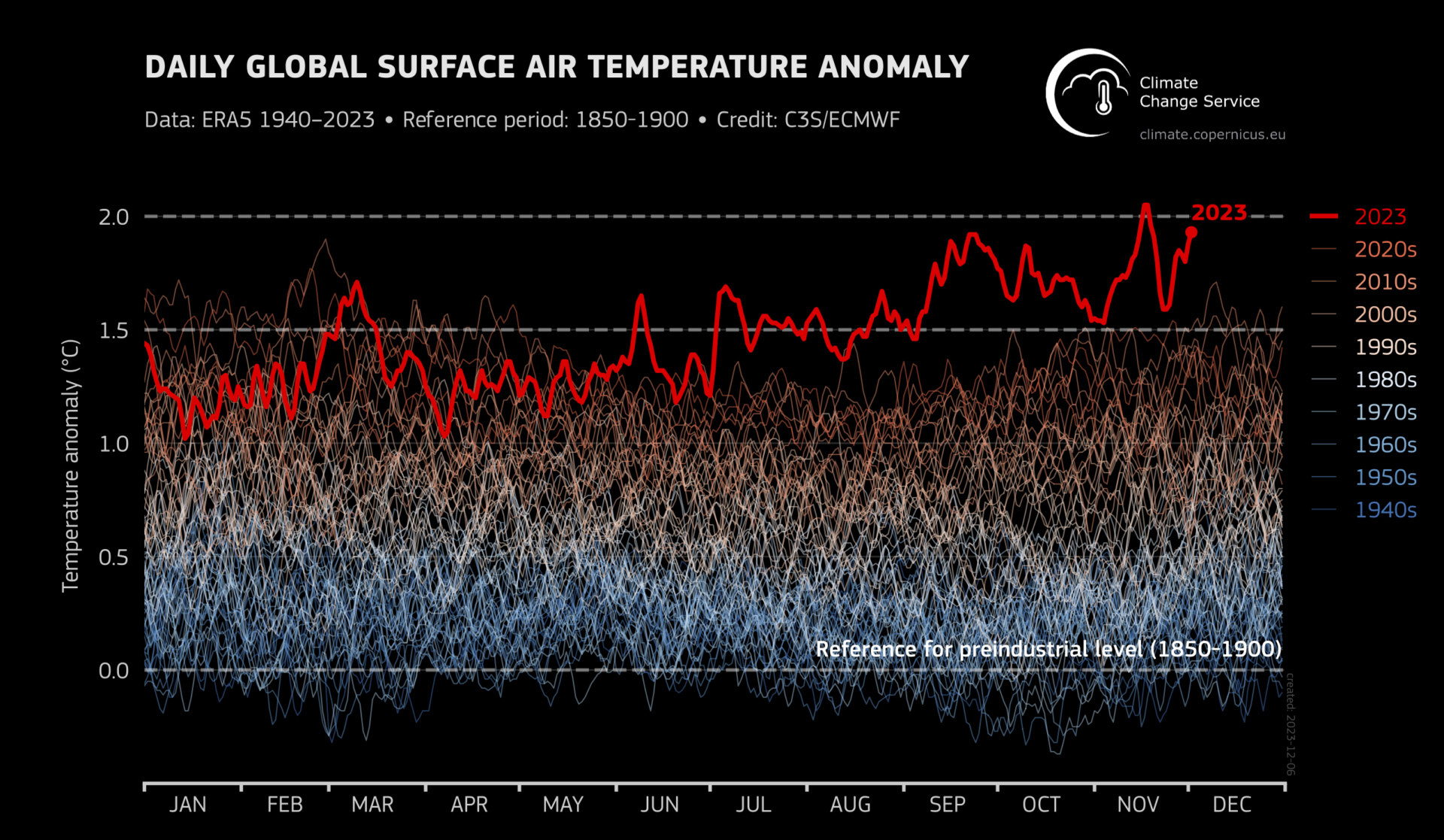A moment of historic danger:
It is still 90 seconds to midnight
2024 Doomsday Clock Statement
Science and Security Board
Bulletin of the Atomic Scientists
Editor, John Mecklin
January 23, 2024

The mixed outlook for climate action
The myriad climate impacts seen around the world in 2023—including massive wildfires, large-scale flooding, and prolonged heat waves—and the continued rise of greenhouse gas emissions are cause for much concern. But the clean-energy transition has also gathered momentum in terms of deployment, investment, and policies related to lowering carbon dioxide emissions.
The world entered “uncharted territory” for climate impacts last year, with conditions exceeding past extremes by enormous margins. The past year was the hottest on record, including extreme summer conditions. Both global and North Atlantic sea-surface temperatures broke records, and Antarctic sea ice reached its lowest daily relative extent since the advent of satellite data, some 2.67 million square kilometers (an area about the size of Kazakhstan) below the 1991–2023 average. Looking ahead, by some estimates, the global surface temperature has a high probability (66 percent) of exceeding 1.5 degrees Celsius above pre-industrial levels—an aspirational goal adopted in the 2015 Paris Agreement—for at least one year between 2023 and 2027. Furthermore, most of the loss of human life (over 90 percent) and a majority of the economic losses (an estimated 60 percent) worldwide from weather-related disasters has occurred in developing countries, highlighting the unequal distribution of climate impacts.
Global greenhouse gas emissions continue to increase. Carbon dioxide equivalent emissions in 2022 were 1.5 percent higher than in 2021, reaching a record high of 57.5 gigatons. The unconditional nationally determined contributions pledged by countries as part of the Paris Agreement process, even if fully implemented, would lead to a temperature rise far above the aspirational goal of 1.5 degrees mentioned in the agreement. The window for raising future commitments and implementing existing commitments to limit warming to the 1.5-degree goal is rapidly narrowing.

Alongside these concerning factors, it is encouraging that the world is seeing record and surging investments in renewables. The latest estimates from the International Energy Agency suggest that of the $2.8 trillion that will be invested in energy in 2023, $1.7 trillion will go to clean energy. But there still are significant investments—more than an estimated $1 trillion in 2023—being made in fossil fuel supply. Solar and wind energy continued to dominate renewable capacity expansion, jointly accounting for 90 percent of all net renewable additions in 2022. This growth in wind and solar led to the highest annual increase in renewable generating capacity and the second highest growth on record in percentage terms. Notably, emerging economies occupy two of the top five spots in total installed solar and wind capacity. Wind and solar energy represented a record 12 percent of global electricity generation in 2022, up from 10 percent in 2021. A recent analysis by the International Energy Agency suggests that with the progress in renewables, the world is on track to see demand for all fossil fuels peak by 2030.
The European Union’s 2023 Green Deal Industrial Plan—in some ways a counterpart to the US Inflation Reduction Act—intends to support the green energy transition in the EU through investments as well as other policies and programs. Such major policy efforts should greatly help industry contribute to climate action.
The world is increasingly aware that achieving the goals of the Paris Agreement requires greatly expanded clean energy deployment not just in developed but also in developing countries—and the world is poorly positioned to accomplish this shift. But efforts to strengthen the approach toward climate finance, catalyzed by the Bridgetown Initiative, are continuing to gain ground. At the same time, there are concerns that many developing countries may miss out on the benefits of the “green tech” revolution without appropriate action from governments and the international community. While developing countries’ exports of green tech rose from $57 billion to $75 billion between 2018 and 2021, their share of the global green tech market fell to 33 percent from 48 percent during this period.
Despite some hopeful signs in the growth of renewables, to halt further warming the world economy must achieve net zero carbon dioxide emissions, and the sooner this is done, the less human suffering from climate disruption there will be. Set against this necessity, the continued rise in carbon dioxide emissions highlights a disturbing fact: The world has not yet entered a trajectory that will lead to net zero.
Learn more about how each of the Bulletin's areas of concern contributed to the setting of the Doomsday Clock this year:
About the Bulletin of the Atomic Scientists
At our core, the Bulletin of the Atomic Scientists is a media organization, publishing a free-access website and a bimonthly magazine. But we are much more. The Bulletin’s website, iconic Doomsday Clock, and regular events equip the public, policy makers, and scientists with the information needed to reduce man-made threats to our existence. The Bulletin focuses on three main areas: nuclear risk, climate change, and disruptive technologies, including developments in biotechnology. What connects these topics is a driving belief that because humans created them, we can control them.
The Bulletin is an independent, nonprofit 501(c)(3) organization. We gather the most informed and influential voices tracking man-made threats and bring their innovative thinking to a global audience. We apply intellectual rigor to the conversation and do not shrink from alarming truths.
The Bulletin has many audiences: the general public, which will ultimately benefit or suffer from scientific breakthroughs; policy makers, whose duty is to harness those breakthroughs for good; and the scientists themselves, who produce those technological advances and thus bear a special responsibility. Our community is international, with half of our website visitors coming from outside the United States. It is also young. Half are under the age of 35.
Learn more at thebulletin.org/about-us.